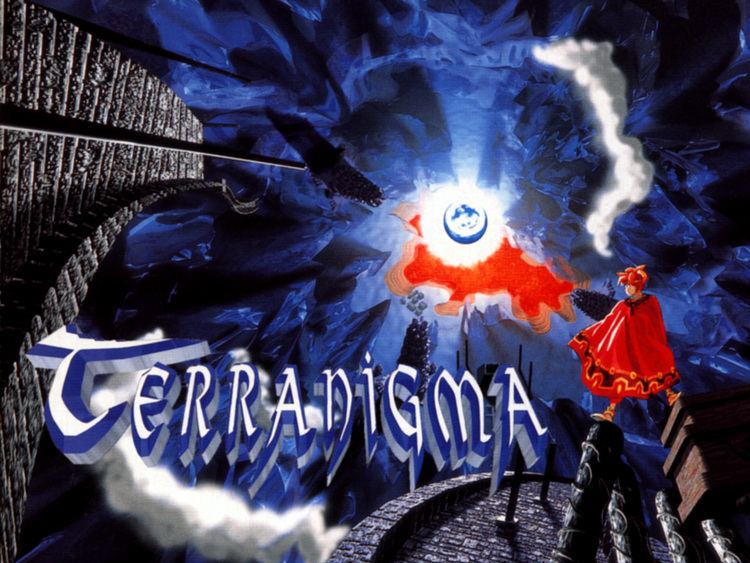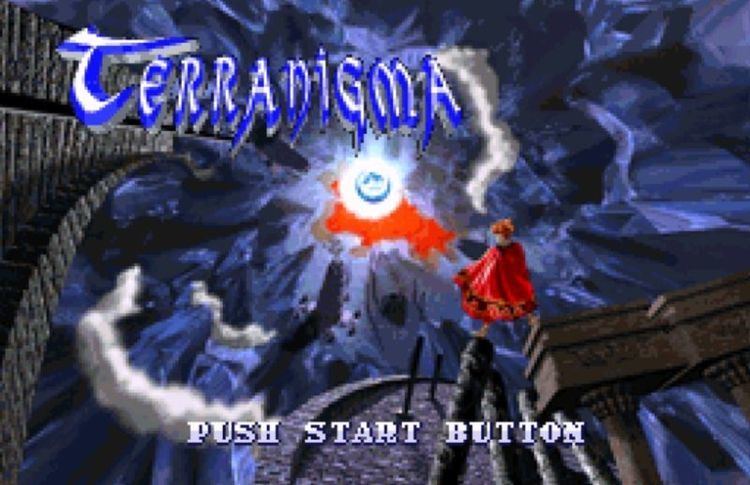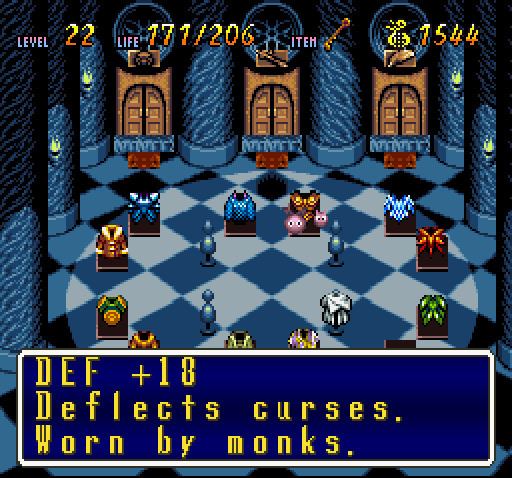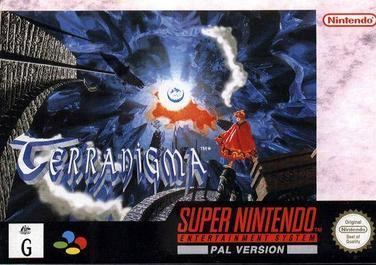9.8 /10 1 Votes
Director(s) Tomoyoshi Miyazaki Initial release date 20 October 1995 Developer Quintet | 4.9/5 Emuparadise Artist(s) Kamui Fujiwara Series Soul Blazer Publishers Nintendo, Enix | |||||||||||||||||||||||||||||||||
 | ||||||||||||||||||||||||||||||||||
Producer(s) Masaya Hashimoto
Shinji Futami
Jun Toda Writer(s) Tomoyoshi Miyazaki
Reiko Takebayashi Composer(s) Miyoko Takaoka
Masanori Hikichi Genre(s) Action role-playing game Platform Super Nintendo Entertainment System Designers Kamui Fujiwara, Tomoyoshi Miyazaki Similar Soul Blazer games, Enix games, Role-playing video games | ||||||||||||||||||||||||||||||||||
Terranigma review snes the game collection
Terranigma, known as Tenchi Sōzō (天地創造, lit. "The Creation of Heaven and Earth") in Japan, is a 1995 action role-playing game for the Super Nintendo Entertainment System developed by Quintet. Manga artist Kamui Fujiwara is credited with the character designs. It was published by Enix (now Square Enix) in Japan before Nintendo localized the game and released English, German, French and Spanish versions in Europe and Australia. The game has never been officially released in North America. Terranigma tells the story of the Earth's resurrection by the hands of a boy named Ark, and its progress from the evolution of life to the present day.
Contents
- Terranigma review snes the game collection
- Terranigma video walkthrough 1 3
- Gameplay
- Setting
- Story
- Development
- Merchandise
- Reception
- References

Terranigma video walkthrough 1 3
Gameplay

The game keeps a top-down perspective view of the world and utilizes an action-based real-time battle system that allows the player to perform different techniques depending on whether the protagonist is running, jumping, attacking, or using a combination of these three actions. Each attack is meant for dealing more damage to certain kinds of enemies, though in most cases there is little to no difference regardless of the technique used. Projectiles launched at Ark can be blocked by the guard technique, which is otherwise ineffective against melee attacks.

With each victory, experience points are gained, increasing the protagonist's level and his maximum hit points, strength, defense, and luck. Slain enemies sometimes leave behind gems which can be used to buy weapons, armors, healing items, and spells. There are no magic points in the game, all spells take the form of one-time use items instead. The player must collect Magirocks and take them to a magic shop to have them transformed into magic rings and summon medals. Those items are used up when casting the corresponding spell and then turn back to Magirocks which may be exchanged for new spells again. Upon defeating bosses and completing miscellaneous tasks, new types of magic become available.
Setting

In Terranigma, the planet (a fictionalized Earth) is portrayed as a hollow sphere (though the map in the game is mathematically a torus) that has both an external and internal face. Since the beginning of the Earth, the external Lightside, the surface world, stood for growth whereas the internal Darkside, the under world, represented decline. Over the course of billions of years, these two forces came to be called God and Devil. Regardless of this inner antagonism, rapid progress took root and primitive life forms evolved to plants, animals, and humans. Technology and industry further expanded civilization, but the fight between God and the Devil was still taking place, more fiercely than ever. The conflict culminated in a final battle in Antarctica, on the surface world. However, neither of the two forces were victorious. The continents of the surface world submerged into the sea and the under world was sealed away.
Story

The first chapter of the game, "The Outset", introduces Ark, a mischievous boy who lives in Crysta, the only village in the under world. After opening a forbidden door and touching a mysterious box containing a friendly demon called Yomi inside, every citizen in the village is frozen. The only person not affected by the curse, the Elder, guides him to resurrect the continents of the surface world in order to unfreeze the people. A way out of his hometown appears, and for the first time ever, a human being leaves Crysta to explore the under world which is portrayed as a frozen wasteland of imposing crystal mountains, crossed by rivers of magma. He conquers the trials of the five towers, each representing one continent, and revives the mainland of the Earth. Upon returning to his hometown, the Elder instructs him to travel to the surface world and to resurrect all living beings. With a heavy heart, Ark says goodbye to his lifelong devoted friend Elle and sets out to the Lightside.

In the second chapter, "Resurrection of the World", Ark is confronted with the barren land that was once the Earth's surface, after having crossed a dimensional crevasse. His first task is to free the giant tree Ra from the parasite he is afflicted with. This causes the resurrection of all plants in the world, helping Ark to cross the mountains of Guiana. He travels further into the world, reviving birds, the wind, animals and eventually humankind.
In the third chapter, "Resurrection of the Genius", the Elder appears to Ark in a dream and tells him to keep helping humankind grow, as the world is still in the fledgling stages. He continues his journey, traveling and expanding cities, assisting with the invention of groundbreaking technologies and also - much to his surprise – encountering a Lightside twin of Elle who lives as the adopted daughter of a French king, but was rendered mute by a traumatic event in her childhood. Ark manages to break this condition, and although Princess Elle at first stays away from Ark, she begins to grow close to him.
In continuing to follow the Elder's commands, Ark ultimately awakes the ingenious Beruga, a scientist who survived the destruction of the previous world by hiding himself in a cryogenic sleep. Beruga provides Ark with an insight into his personal image of the paradise: A perfect world where all insignificant life is killed with a virus named Asmodeus and everyone else is made immortal by turning them into zombies. Ark tries to attack Beruga after this revealing twist but is stopped by robots, injuring him heavily.
The Elder once again appears to him, saying that his mission is fulfilled and he may now pass away. Ark realizes that he's been used by Dark Gaia (the "Devil"), whose plans of world domination required Ark to resurrect the planet. Just as he is about to die, Kumari, a wise human who watched the world's growth through reincarnation, teleports Ark out of Beruga's laboratory. He then instructs him to go search the five Starstones and to lay them at the grave at time's end in order to call the golden child. Ark obtains the stones one after another and sets them into skull statues at Dryvale, the location at the South Pole where the final confrontation between God and the Devil once took place. This leads to the appearance of Ark's Lightside self; the person Dark Gaia used to create Ark himself. He reveals to him that he, the underworld Ark, is the legendary hero and then kills him.
However, in the fourth and final chapter, "Resurrection of the Hero", Ark is reborn as a baby through the soul of the surface world, Light Gaia. He is kidnapped by Darkside Elle, who was led there by Yomi to eliminate a threat to Crysta. Realizing this threat is actually Ark, she stops her actions, allowing him to awaken as the legendary hero and grow back into an adult in the process. Yomi then decides to kill Ark by himself and reveals he has been working for Dark Gaia all along. He fails, as Darkside Elle sacrifices herself to kill Yomi and save Ark's life.
Afterwards, Ark departs to defeat Beruga. After having conquered the professor, he returns to the underworld to defeat Dark Gaia. The victory over that entity brings forth the destruction of the Darkside. In the end, however, Ark realizes that having been created by Dark Gaia, he, along with the village of Crysta and the underworld, shall now vanish with the Devil's demise, though it is implied he and his loved ones in Crysta will be reincarnated. He goes to sleep, after being told by Light Gaia that he, as creator and defender, is what the humans would call a god. Ark's last dream pictures him as a bird flying above the world that he helped to exist, watching it grow older. An epilogue plays which shows Lightside Elle at her original home. There is a knock at the door and she answers it. The game then ends.
Development
Terranigma was developed by the Japanese company Quintet, which had previously designed creation-themed Super NES games such as ActRaiser and Soul Blazer. Publisher Enix commissioned the developers as a subcontractor and decided for the title to be an action role-playing game for strategic reasons, based on Quintet's experience in that particular genre and the good reception of their earlier games by Japanese players. The theme of creation prevalent in Terranigma was introduced as a contrast to the destruction of enemies in other action titles, and to inspire the player's imagination concerning the effects their actions might have. The script was written by director and designer Tomoyoshi Miyazaki, the founder of Quintet, with the scenario provided by Reiko Takebayashi. Tatsuo Hashimoto created the computer graphics cover art and also rendered the background images for the resurrection scenes. The music of Terranigma was composed by Miyoko Takaoka and Masanori Hikichi, the latter of whom was responsible for the design of the sounds as well. Terranigma wound up never being published in North America because Enix had already closed its US subsidiary by the time the localization was finished.The English scripts of the game used in the European and Australian releases by Nintendo were translated by Colin Palmer, Dan Owsen and Hiro Nakamura.
Merchandise
Terranigma was released alongside several pieces of merchandise in Japan, including an official guide book, a world atlas, a novel by Saori Kumi, a novelization by Norio Nakai titled Logout Bunko Tenchi Sōzō, a gamebook featuring artwork by character designer Kamui Fujiwara, and the two volume manga Gangan Fantasy Comics: Tenchi Sōzō by Mamiko Yasaka. Except the guide book, none of these materials have been released outside Japan, though in Germany, Club Nintendo published a 32-page comic illustrating scenes from the game up to the events of the third chapter.
A Japanese soundtrack album titled Tenchi Sōzō Creative Soundtracks with 33 compositions was released by Kitty Enterprises on October 25, 1995. The first six tracks are arranged versions of the game's music.
Reception
According to developer Quintet, Tenchi Sōzō sold 200,000 copies in Japan. On release, Famicom Tsūshin scored the game a 30 out of 40.
Jeremy Parish of 1UP.com's Retronauts podcast described it as the game with the best reputation in Quintet's creation trilogy. He remarked that the series was "full of solid gameplay, great music and surprisingly deep story themes", and that Terranigma exceeded both Soul Blazer and Illusion of Gaia, "making it a long-coveted classic". Parish also expressed his wish for the title to be released on the Wii's Virtual Console download service. Kei Kuboki of the video game magazine GameFan described it as the developer's "best (...) effort", and as being "among the [Super NES's] most memorable titles".
